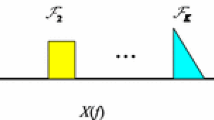Abstract
This paper considers the orthogonal observation matrix design of deterministic compressive sampling (CS). An observation matrix called the weighted truncated Hadamard-modulated wideband converter (WITH-MWC) is deterministically designed based on the truncated Hadamard matrix. This matrix can meet the restricted isometry property (RIP) condition with overwhelming probability by randomly or strategically extracting from a standard Hadamard matrix. Most compressed sampling systems are highly sensitive to noise. To reduce the adverse effects of noise interference, partial specific matrix elements are weighted according to the sparse characteristics of multiband signals, and the recovery probability is provably better than that of the original system and other deterministic observation matrices, especially in the low signal-to-noise ratio scenario. Compared to the random Gaussian and random Bernoulli matrices, WITH-MWC is much easier to implement in hardware. The simulations verify the above analysis.










Similar content being viewed by others
Data Availability Statement
The datasets generated during and/or analyzed during the current study are available on Github at https://github.com/1noS/WITH MWC.git
References
I. Ahmed, A. Khan, A. Khan, K. Mujahid, N. Khan, Efficient measurement matrix for speech compressive sampling. Multimed. Tools Appl. 20(13), 20327–20343 (2021). https://doi.org/10.1007/s11042-021-10657-x
Z. Cai, H. Zhao, M. Jia, G. Wang, J. Shen, An improved hadamard measurement matrix based on walsh code for compressive sensing. In: 2013 9th International Conference on Information, Communications Signal Processing, pp. 1–4 (2013). https://doi.org/10.1109/ICICS.2013.6782833
E.J. Candes, J. Romberg, T. Tao, Robust uncertainty principles: exact signal reconstruction from highly incomplete frequency information. IEEE Trans. Inf. Theory 52(2), 489–509 (2006). https://doi.org/10.1109/TIT.2005.862083
H. Chen, C.H. Vun, A feature-based compressive spectrum sensing technique for cognitive radio operation. Circuits Syst Signal Process 37(3), 1287–1314 (2018). https://doi.org/10.1007/s00034-017-0610-x
D.L. Donoho, Compressed sensing. IEEE Trans. Inf. Theory 52(4), 1289–1306 (2006). https://doi.org/10.1109/TIT.2006.871582
H. Gan, S. Xiao, Z. Zhang, S. Shan, Y. Gao, Chaotic compressive sampling matrix: where sensing architecture meets sinusoidal iterator. Circuits Syst Signal Process 39(3), 1581–1602 (2020). https://doi.org/10.1007/s00034-019-01223-w
W.B. Johnson, J. Lindenstrauss, Extensions of lipschitz mappings into a hilbert space. Contemp. Math. 26(189–206), 1 (1984)
K. Li, C. Ling, L. Gan, Deterministic compressed-sensing matrices: Where toeplitz meets golay. In: 2011 IEEE International Conference on Acoustics, Speech and Signal Processing (ICASSP), pp. 3748–3751 (2011). https://doi.org/10.1109/ICASSP.2011.5947166
G. Lu, K. Li, C. Ling, Golay meets hadamard: Golay-paired hadamard matrices for fast compressed sensing. In: 2012 IEEE Information Theory Workshop, pp. 637–641 (2012). https://doi.org/10.1109/ITW.2012.6404755
M. Mishali, Y.C. Eldar, Wideband spectrum sensing at sub-nyquist rates [applications corner]. IEEE Signal Process. Mag. 28(4), 102–135 (2011). https://doi.org/10.1109/MSP.2011.941094
L. Ou, S. Liao, Z. Qin, H. Yin, Millimeter wave wireless hadamard image transmission for mimo enabled 5g and beyond. IEEE Wirel. Commun. 27(6), 134–139 (2020). https://doi.org/10.1109/MWC.001.2000081
A. Ravelomanantsoa, H. Rabah, A. Rouane, Compressed sensing: a simple deterministic measurement matrix and a fast recovery algorithm. IEEE Trans. Instrum. Meas. 64(12), 3405–3413 (2015). https://doi.org/10.1109/TIM.2015.2459471
H. Sun, A. Nallanathan, C. Wang, Y. Chen, Wideband spectrum sensing for cognitive radio networks: a survey. IEEE Wirel. Commun. 20(2), 74–81 (2013). https://doi.org/10.1109/MWC.2013.6507397
J. Tropp, A. Gilbert, M. Strauss, Algorithms for simultaneous sparse approximation. Part i Greedy pursuit. Signal Process. 86(3), 572–588 (2006). https://doi.org/10.1016/j.sigpro.2005.05.030
R. Wang, J. Guo, H. Leung, Orthogonal circulant structure and chaotic phase modulation based analog to information conversion. Signal Process. 144, 104–117 (2018). https://doi.org/10.1016/j.sigpro.2017.10.003
X. Xu, G. Li, Y. Gu, Unraveling the veil of subspace rip through near-isometry on subspaces. IEEE Trans. Signal Process. 68, 3117–3131 (2020). https://doi.org/10.1109/TSP.2020.2984905
W.-K. Yu, Super sub-nyquist single-pixel imaging by means of cake-cutting hadamard basis sort. Sensors 19(19), 4122 (2019). https://doi.org/10.3390/s19194122
J. Zhang, X. Zhang, Y. Su, L. Qiao, Stairs sequence based analog to information conversion for spectrum sensing of multiband signals. In: 2020 15th IEEE International Conference on Signal Processing (ICSP), vol. 1, pp. 199–204 (2020). https://doi.org/10.1109/ICSP48669.2020.9321016
J. Zhang, N. Fu, X. Peng, Compressive circulant matrix based analog to information conversion. IEEE Signal Process. Lett. 21(4), 428–431 (2014). https://doi.org/10.1109/LSP.2013.2285444
Acknowledgements
This work is supported by National Natural Science Foundation of China under grant 61701138 and by the Hei Long Jiang Postdoctoral Foundation under Grant LBH-Z16087 and by the Natural Science Foundation of Heilongjiang Province of China under Grant LH2022F019.
Author information
Authors and Affiliations
Corresponding author
Additional information
Publisher's Note
Springer Nature remains neutral with regard to jurisdictional claims in published maps and institutional affiliations.
Appendices
Appendix
Proof of lemma 1
According to the JL lemma, for all \(n \times n \) matrices decimated from a Gaussian random variables set (J), the probability that the inner product of any two different vectors deviates from 0 decreases exponentially with the increase in n. Therefore, the similarity of a Gaussian distributed matrix to an orthogonal matrix can be expressed by the following probability:
where \( u,v \in R^{n} \) are independently and randomly sampled from J.
Because \(u,v\sim N(0,\frac{1}{n})\), then \(\dfrac{u\pm v}{\sqrt{2}}\sim N(0,\frac{1}{n})\).
From the JL lemma,
Because
Therefore,
Similarly,
Finally, Theorem 1 can be obtained:
Rights and permissions
Springer Nature or its licensor holds exclusive rights to this article under a publishing agreement with the author(s) or other rightsholder(s); author self-archiving of the accepted manuscript version of this article is solely governed by the terms of such publishing agreement and applicable law.
About this article
Cite this article
Su, Y., Zhang, J. & Qiao, L. WITH: Weighted Truncated Hadamard-Matrix-Based Deterministic Compressive Sampling for Sparse Multiband Signals. Circuits Syst Signal Process 42, 1723–1741 (2023). https://doi.org/10.1007/s00034-022-02191-4
Received:
Revised:
Accepted:
Published:
Issue Date:
DOI: https://doi.org/10.1007/s00034-022-02191-4




